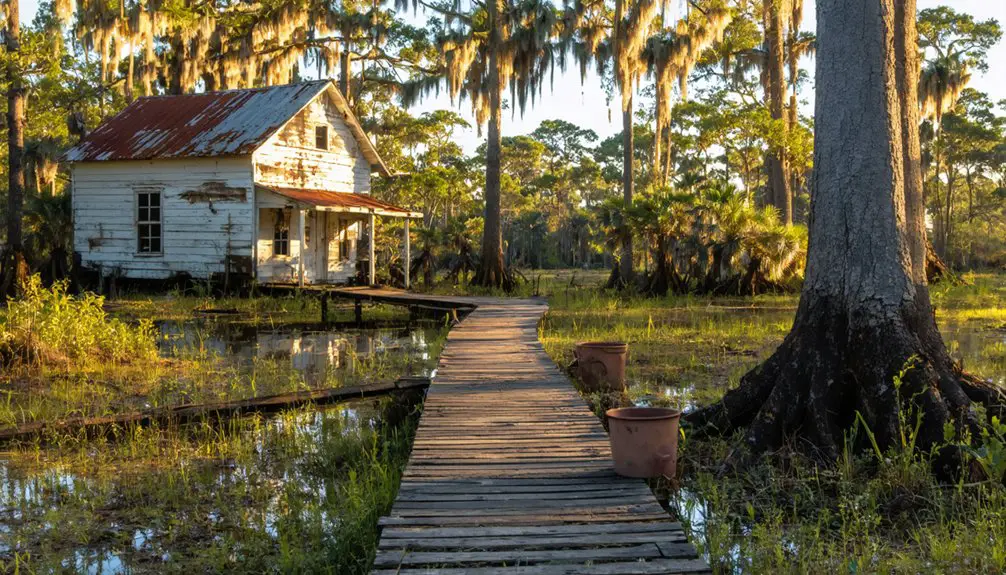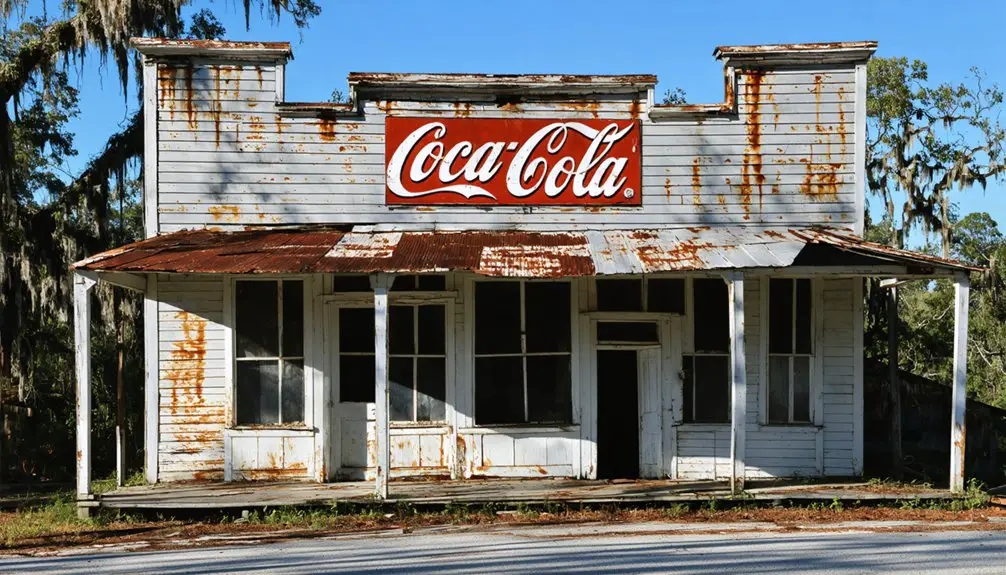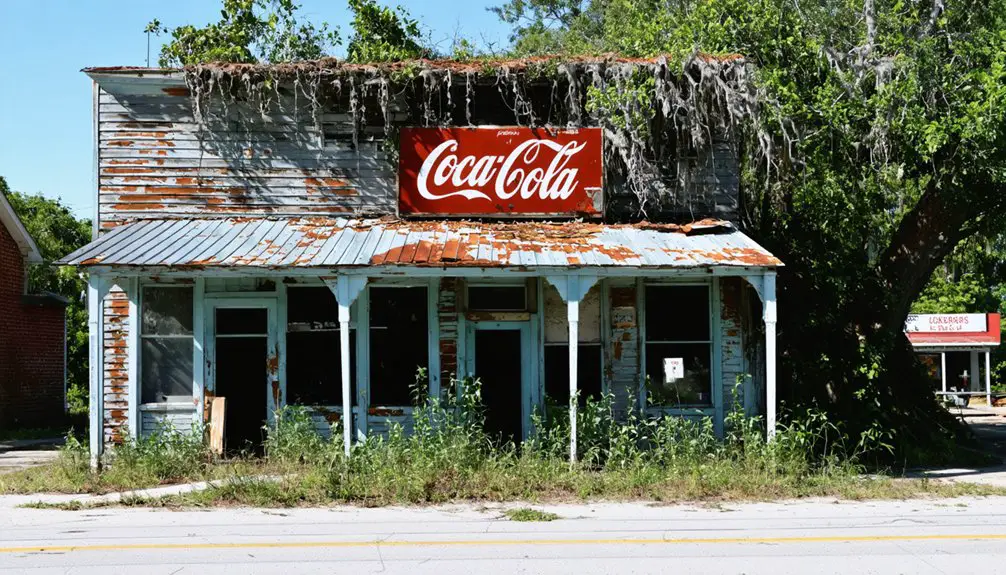You’ll find Barrsville’s ruins hidden in Florida’s pine forests, where George Franklin Drew established a thriving lumber empire in 1861. The town quickly grew to 1,000 residents, with Drew’s steam-powered mill employing 500 workers across lumber and turpentine operations. Despite its peak prosperity earning Drew the nickname “Millionaire Drew,” Barrsville’s fortunes declined as timber resources were depleted. Today, archaeological surveys reveal scattered foundations, artifacts, and cemetery sites that tell a deeper story of this once-bustling industrial powerhouse.
Key Takeaways
- Barrsville was once a thriving industrial town built around George Franklin Drew’s lumber operation, which employed 500 workers at its peak.
- The town’s economy relied heavily on timber and turpentine production, with a population reaching 1,000 during its boom years.
- Economic decline began when surrounding pine forests were depleted through overharvesting and unsustainable turpentine extraction methods.
- After the mills closed due to resource exhaustion, the population dwindled and Barrsville eventually transformed into a ghost town.
- Archaeological surveys have uncovered building foundations, industrial artifacts, and cemetery sites that preserve Barrsville’s historical legacy.
The Rise of a Thriving Mill Town
While many Florida towns sprouted from agricultural roots, Ellaville emerged in 1861 as an industrial powerhouse when George Franklin Drew established a sawmill on the western banks of the Suwannee River.
Drew named the settlement after Ella, his loyal African-American servant, and partnered with Louis Bucki to transform this mill town into Florida’s largest lumber operation. At its peak, the operation employed five hundred workers and expanded into turpentine production and railroad car manufacturing. Drew’s success in Ellaville helped launch his political career, leading to his role as Florida’s 12th governor.
Life in Early 20th Century Barrsville
Life in Barrsville during the early 1900s reflected the typical hardships and close-knit dynamics of Florida’s mill towns. You’d have found a community where mill workers and their families lived in simple wooden houses, clustered tightly around the sawmill for easy access to work.
The community dynamics centered on shared labor struggles, with residents supporting each other through informal networks despite the challenging conditions they faced. Black workers faced particularly harsh treatment as labor shortages led to increased arrests on minor charges to meet mill demands. Workers endured long days of physically demanding work, often in intense heat with few safety protections. The devastating Great Freeze of 1894 had forced many Florida agricultural workers to seek employment in lumber mills like Barrsville’s.
While segregation divided the housing areas, churches and schools served as essential gathering places. You’d have seen children attending basic schoolhouses, families shopping at the general store, and residents coming together for picnics and dances – activities that strengthened their bonds despite the daily hardships they faced.
Economic Pillars and Industrial Heritage
During the early 1900s, Barrsville’s economic foundation rested firmly on its thriving logging and sawmill operations, with George Franklin Drew’s steam-powered mill serving as the town’s industrial heart.
You’d find this timber economy buzzing with activity as hundreds of workers processed the region’s abundant forests, while steamboats and trains carried lumber to distant markets.
Drew’s industrial innovation transformed Barrsville into a boomtown of 1,000 residents, earning him the nickname “Millionaire Drew.”
The town’s strategic location along the river, combined with its rail infrastructure, created perfect conditions for economic growth.
Unfortunately, like many unavailable videos today, much of Barrsville’s original infrastructure has been lost to time.
Supporting businesses flourished, including commissaries, docks, and trade services.
Through partnerships with entrepreneurs like Louis Bucki, Drew’s investments in infrastructure helped Barrsville become a pivotal player in north Florida’s industrial landscape.
The town’s success was further enhanced by the addition of prominent social structures including a Masonic lodge, churches, and schools.
Educational Excellence and Community Pride
You’ll find that Barrsville’s commitment to education centered around its modest schoolhouse, where local children received basic instruction while their families worked in the logging and turpentine industries.
The community’s dedication to learning became evident through their collective efforts to plant trees around the schoolhouse grounds, creating an environment that fostered both education and civic pride.
Though few academic records survive from Barrsville’s peak period, the town’s emphasis on education helped residents adapt to changing economic conditions until its eventual decline in the late 1800s.
Like many Florida settlements, the town succumbed to economic downturns that drove families to seek opportunities elsewhere.
Like many towns of that era including Oak Grove Missionary Baptist, the local church served as both a spiritual and educational center for the community.
Academic Achievement Records
Despite limited surviving records from Barrsville’s educational system, historical documents suggest the town’s schools maintained respectable academic standards through the early 1900s.
Like other Florida ghost towns of the era, you’ll find that academic records reflect the determined spirit of a community that valued education despite challenging circumstances.
Students walked up to 8 miles each day to attend classes, demonstrating their dedication to learning despite transportation hardships.
The town’s educational achievements were particularly notable given the basic infrastructure and seasonal attendance challenges.
Similar to the white children’s school that became Annie Lytle Elementary in Jacksonville in 1891, Barrsville’s educational institutions served as important community anchors.
Students often balanced their studies with contributing firewood for the school’s heating and helping with family labor demands.
While formal academic records may be scarce, the preservation efforts of local historical groups have kept alive the legacy of Barrsville’s commitment to learning, much like neighboring communities such as Centralia where schools served as proud symbols of progress amid economic uncertainty.
Lasting Educational Impact
While Barrsville’s physical structures have vanished, the town’s educational legacy endures through its innovative approach to vocational training and community-centered learning.
Like other African American communities of its time, Barrsville demonstrated remarkable educational resilience through its commitment to practical education and self-sufficiency.
- You’ll find that Barrsville’s educational model mirrored successful institutions like the Hungerford School, focusing on agricultural skills and trades that fostered economic independence.
- The town’s emphasis on community empowerment through education created lasting impacts on regional development.
- Despite physical deterioration, the educational heritage continues to inspire modern preservation efforts.
- The town’s approach to vocational training set standards for combining practical skills with academic excellence, influencing educational practices throughout Florida.
Religious and Social Foundations

You’ll discover that Barrsville’s churches served as essential hubs where residents gathered for worship, social events, and mutual support during the settlement’s peak years.
Local faith leaders, both permanent ministers and traveling preachers, strengthened community bonds through regular services and pastoral care in the small Florida town.
The traditional worship gatherings, which included potlucks and holiday celebrations, created lasting connections among Barrsville’s families until the town’s eventual decline.
Churches Unite The Community
Throughout Barrsville’s history, churches served as essential cornerstones that unified the community far beyond their religious functions. These sacred spaces fostered strong social bonds through regular community gatherings, creating a sense of belonging and shared purpose among residents.
The churches’ impact on Barrsville’s social fabric was profound, as demonstrated by:
- Hosting crucial community events like holiday celebrations and communal meals that brought people together.
- Operating educational programs including Sunday schools and literacy initiatives.
- Coordinating charitable efforts to support struggling families during economic hardships.
- Maintaining detailed records of births, marriages, and deaths that preserved the town’s heritage.
You’ll find that both Baptist and Methodist congregations worked together to sustain Barrsville’s infrastructure, pooling resources for construction projects and community welfare programs that strengthened local bonds.
Faith Leaders’ Local Impact
The faith leaders of Barrsville wielded influence far beyond their religious duties, shaping the town’s social welfare system through organized charitable programs and community outreach.
Through their faith outreach initiatives, they established crucial support networks, distributing food, clothing, and medical assistance to vulnerable residents while coordinating fundraisers to sustain essential services.
You’ll find their impact reflected in the town’s educational legacy, where church-founded schools achieved higher graduation rates than neighboring rural areas.
Their dedication to community resilience showed in how they preserved local traditions, mediated disputes, and protected cultural heritage.
Even as Barrsville’s population declined, these spiritual leaders maintained social cohesion through religious festivals, burial services, and memorial events that strengthened bonds between remaining residents and honored the town’s shared history.
Worship Traditions And Gatherings
While settlers first gathered for worship in modest homes and temporary structures, Barrsville’s religious foundation crystallized around permanent church buildings by the mid-19th century.
Protestant worship practices, primarily Methodist and Baptist, shaped the spiritual landscape as residents established regular services.
- Sunday morning worship featured traditional hymns and scripture readings, often followed by community potlucks.
- Special revival meetings and prayer groups maintained spiritual continuity between formal services.
- Holiday celebrations and seasonal gatherings brought together diverse community members.
- Sunday schools provided religious education while strengthening social bonds among families.
The church’s influence extended beyond spiritual matters, serving as a hub for community gatherings where you’d find townspeople sharing news, organizing local affairs, and supporting one another through life’s milestones, from weddings to funerals.
The Decline of Timber and Turpentine

During the early twentieth century, Barrsville’s heavy reliance on timber extraction and turpentine production proved catastrophic as natural resources rapidly depleted.
You would’ve witnessed the devastating effects of timber depletion as overharvesting exhausted the surrounding pine forests, mirroring a pattern seen across North Florida. The turpentine decline accelerated when the box system damaged longleaf pines, reducing sustainable yields and preventing forest regeneration.
Steam-powered sawmills, while initially boosting production, only hastened the area’s downfall. When Herty’s 1932 paper pulp innovation shifted industry demands, Barrsville couldn’t adapt.
You’d have seen workers leaving in droves as mills closed, unable to compete with other regions or compensate for the shrinking timber supply. The once-bustling company town gradually transformed into the ghost town you’ll find today.
Archaeological Discoveries and Remnants
Archaeological surveys near Barrsville have revealed scattered remnants of its former industrial and residential life, though no official site records specifically identify the town’s exact location.
Modern archaeological methods, including ground penetrating radar and surface collection, have helped researchers piece together evidence of the settlement’s past.
Through careful artifact analysis, investigators have documented:
- Building foundations from homes, mills, and community structures
- Industrial artifacts like turpentine cups, tram rails, and logging equipment from early 1900s operations
- Domestic items including glass fragments, ceramics, and daily use tools
- Historic cemetery sites with both marked and unmarked graves
These discoveries align with other ghost town findings in Seminole County, where similar remains help tell the story of Florida’s early timber and turpentine communities.
Legacy and Historical Preservation

The legacy of Barrsville endures through dedicated preservation efforts and local cultural memory, despite the town’s physical disappearance.
Though Barrsville’s buildings have vanished, its spirit lives on through community dedication to preserving its memory and heritage.
You’ll find its story woven into the broader narrative of Florida’s boom-and-bust cycles, particularly through the lens of timber and turpentine industries that once dominated the region’s economy.
Local historians and volunteer groups have championed the preservation of Barrsville’s cultural memory through organized tours, documentation projects, and educational programs.
They’ve partnered with state preservation boards to protect remaining structures while sharing the town’s history with visitors.
These preservation efforts extend beyond physical conservation – they’re about keeping alive the stories of resilience and adaptation that characterized early Florida settlers.
Through heritage tourism and guided interpretive programs, you’re now able to experience Barrsville’s significance within Florida’s historical landscape.
Frequently Asked Questions
What Happened to the Families Who Lived in Barrsville After It Was Abandoned?
You’ll find that families relocated throughout Florida seeking work after the sawmill’s closure, with many settling in nearby logging towns while preserving their community memories through oral histories passed down generations.
Were There Any Notable Crimes or Incidents in Barrsville’s History?
While you might hope for ghostly sightings or unsolved mysteries, there’s no documented evidence of major crimes in the area. Regional records show racial tensions and civil disputes affected nearby communities instead.
What Indigenous Peoples Inhabited the Barrsville Area Before the Mill Town?
You’d find evidence of early Timucua influence in the region, followed by Seminole Tribes who migrated south from Georgia in the 18th century, establishing settlements in and around today’s Barrsville area.
Did Any Famous Visitors or Politicians Ever Pass Through Barrsville?
You won’t find records of any famous visitors or political figures in Barrsville’s history. While the town had a hotel and sanitarium for health-seeking tourists, no notable personalities were documented there.
What Natural Disasters Affected Barrsville During Its Active Years?
Like many Florida frontier settlements caught in nature’s crosshairs, you’d have faced devastating hurricane impacts in the 1890s and chronic flood damage from nearby waterways that ultimately contributed to the town’s decline.
References
- https://www.emeraldcoastmagazine.com/ghost-towns-of-west-florida/
- https://freepages.history.rootsweb.com/~gtusa/usa/fl.htm
- https://cccourthouse.org/wp-content/uploads/2023/12/Ghost-towns-and-Cemeteries-of-Citrus-County.pdf
- https://patchproflorida.com/blog/the-fascinating-history-of-floridas-ghost-towns/
- https://www.tiktok.com/@socialshepherdadventures/video/7342301852702100778
- https://abandonedfl.com/the-town-of-ellaville/
- https://www.youtube.com/watch?v=yJ4TrNBZ0Sk
- https://www.atlasobscura.com/places/the-ghost-town-of-ellaville-madison-florida
- https://theforgottensouth.com/ghost-town-ellaville-florida-history-governor-drew-mansion/
- https://www.worldatlas.com/travel-stories/north-florida-s-infamous-ghost-town.html



